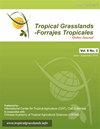土地利用变化的理化和生物指标评价
IF 0.7
4区 农林科学
Q3 AGRICULTURE, DAIRY & ANIMAL SCIENCE
引用次数: 2
摘要
将森林转化为农业用地可以极大地改变土壤性质,但土壤抵抗力,即土壤性质或过程在面对特定干扰或压力时保持不变的能力,仍然不清楚。我们通过分析用于评估土壤抗性的理化变量和生物指标(无量纲抗性指数,+1代表最高抗性,-1代表最低抗性),评估了哥伦比亚卡考卡省土地利用变化和农业管理对土壤土壤变化的影响。所分析的土地利用包括:(1)森林,大约有100年的历史,加上在1985年(即观测前30年)被(2)天然牧场和(3)饲料作物取代的同一森林面积(70%的面积)。除土壤粘粒含量外,其他理化指标均受森林向天然牧场转变的显著影响。同样,从森林种植到饲料种植的变化影响了所有的理化变量,并导致土壤微生物生物量减少,但微生物活性增加。结果表明,代谢商(-0.32)的抗性最低,其次是微生物系数(0.19)、微生物生物量(0.32)和微生物活性(0.39),表明扰动引起的土壤胁迫对土壤微生物区系的数量和活性有显著影响。相比之下,从森林到天然牧场的变化对微生物生物量及其活性没有任何影响,这表明通过多种根系有机残留物的供应以及牲畜尿液和粪便中的营养物质向土壤持续输入有机质有利于土壤中微生物过程的保存和抵抗。这些结果表明,毁林后建立天然牧场对土壤稳定性和健康的影响小于毁林后开垦土壤。本文章由计算机程序翻译,如有差异,请以英文原文为准。
Evaluation of land use change on an andosol through physicochemical and biological indicators
The conversion of forests to agricultural land can dramatically alter soil properties, but soil resistance, which is theability of soil properties or processes to remain unchanged in the face of a specific disturbance or stress, remainsunclear. We evaluated the impact of land use change and agricultural management on changes on an andosol in theCauca department, Colombia, through the analysis of physicochemical variables and biological indicators (dimensionlessresistance index, where +1 is the highest resistance and -1 is the lowest resistance) that allowed the assessment of soilresistance. The land uses analyzed included (1st) forest, which was approximately 100 years of age, plus areas of the same forest (70% of the area), which had been replaced by (2nd) natural pastures and (3rd) forage crops in the year 1985, i.e. 30 years before the observations. All physicochemical variables except soil clay content were significantly affected by the change from forest to natural pasture. Similarly, the change from forest to forage cropping affected all physicochemical variables as well as resulting in a decrease in soil microbial biomass but an increase in microbial activity. We found that the metabolic quotient (-0.32) had the lowest resistance, followed by the microbial coefficient (0.19), microbial biomass (0.32) and microbial activity (0.39), suggesting that soil stress caused by disturbance has a marked impact on the number and activity of the soil microflora. By contrast the change from forest to natural pastures was not associated with any effect on microbial biomass and its activity, suggesting that the continuous input of organic matter to the soil through the supply of organic residues from diversified root systems and nutrients from livestock urine and manure favored the preservation and resistance of microbial processes in the soil. These findings suggest that deforestation to establish natural pasture has less impact on soil stability and health than cultivating the soil following clearing.
求助全文
通过发布文献求助,成功后即可免费获取论文全文。
去求助
来源期刊

Tropical Grasslands-Forrajes Tropicales
Agricultural and Biological Sciences-Agronomy and Crop Science
CiteScore
1.60
自引率
0.00%
发文量
36
审稿时长
16 weeks
期刊介绍:
The Journal publishes, in English or Spanish, Research Papers and Short Communications on research and development, as well as contributions from practitioners (Farmer Contributions) and Review Articles, related to pastures and forages in the tropics and subtropics. There is no regional focus; the information published should be of interest to a wide readership, encomprising researchers, academics, students, technicians, development workers and farmers.
In general, the focus of the Journal is more on sown (''improved'') pastures and forages than on rangeland-specific aspects of natural grasslands, but exceptions are possible (e.g. when a submission is relevant for a particularly broad readership in the pasture and forage science community).
The Journal will also consider the occasional publication of associated, but closely related, research in the form of an additional scientific communication platform [e.g. a re-make of the former Genetic Resources Communication series of the former Division of Tropical Crops and Pastures of the Commonwealth Scientific and Industrial Research Organisation (CSIRO), Australia].
Areas of particular interest to the Journal are:
Forage Genetic Resources and Livestock Production[...]
Environmental Functions of Forages[...]
Socio-economic Aspects[...]
Topics within the aforementioned areas may include: Diversity evaluation; Agronomy; Establishment (including fertilization); Management and utilization; Animal production; Nutritive value; Biotic stresses (pests and diseases, weeds); Abiotic stresses (soil fertility, water, temperature); Genetics and breeding; Biogeography and germplasm collections; Seed production; Ecology; Physiology; Rhizobiology (including BNF, BNI, mycorrhizae); Forage conservation; Economics; Multilocational experimentation; Modelling.
 求助内容:
求助内容: 应助结果提醒方式:
应助结果提醒方式:


